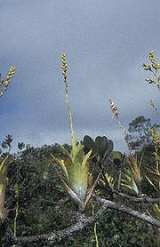
Catopsis berteroniana
Encyclopedia
Catopsis berteroniana is an epiphytic
bromeliad thought to be a possible carnivorous plant
, similar to Brocchinia reducta
, although the evidence is equivocal. Its native range is from southern Florida
to southern Brazil
. It generally grows on the unshaded twigs of trees, and appears to trap more insects in its tank than other bromeliads of comparable size. There are several other species in the genus, none of which is believed to be carnivorous.
Epiphyte
An epiphyte is a plant that grows upon another plant non-parasitically or sometimes upon some other object , derives its moisture and nutrients from the air and rain and sometimes from debris accumulating around it, and is found in the temperate zone and in the...
bromeliad thought to be a possible carnivorous plant
Carnivorous plant
Carnivorous plants are plants that derive some or most of their nutrients from trapping and consuming animals or protozoans, typically insects and other arthropods. Carnivorous plants appear adapted to grow in places where the soil is thin or poor in nutrients, especially nitrogen, such as acidic...
, similar to Brocchinia reducta
Brocchinia reducta
Brocchinia reducta is one of few carnivorous bromeliads. It is native to southern Venezuela, Brazil and Guyana, and is found in nutrient-poor soil....
, although the evidence is equivocal. Its native range is from southern Florida
Florida
Florida is a state in the southeastern United States, located on the nation's Atlantic and Gulf coasts. It is bordered to the west by the Gulf of Mexico, to the north by Alabama and Georgia and to the east by the Atlantic Ocean. With a population of 18,801,310 as measured by the 2010 census, it...
to southern Brazil
Brazil
Brazil , officially the Federative Republic of Brazil , is the largest country in South America. It is the world's fifth largest country, both by geographical area and by population with over 192 million people...
. It generally grows on the unshaded twigs of trees, and appears to trap more insects in its tank than other bromeliads of comparable size. There are several other species in the genus, none of which is believed to be carnivorous.

